Bathroom Plants That Absorb Moisture
Excess moisture in your bathroom can cause condensation on surfaces, wet spots and musty smells. You can naturally balance the levels of humidity by introducing moisture-absorbing indoor plants. These plants will not only stabilize the humidity levels but also make your bathroom attractive and fresh.
Plants that can absorb moisture in your bathroom include Philodenron, Nerve Plant, Zanzibar Gem, Bird’s Nest Fern, Cast Iron Plant, Cyclamen, Begonia, Tillandsia, Spider Plant, Reed Palm, Snake Plant and more. Read on details.
Cast Iron Plant
This bathroom plant is great in absorbing excess moisture in the air and does not need a lot of watering unless the soil or potting mix is too dry.
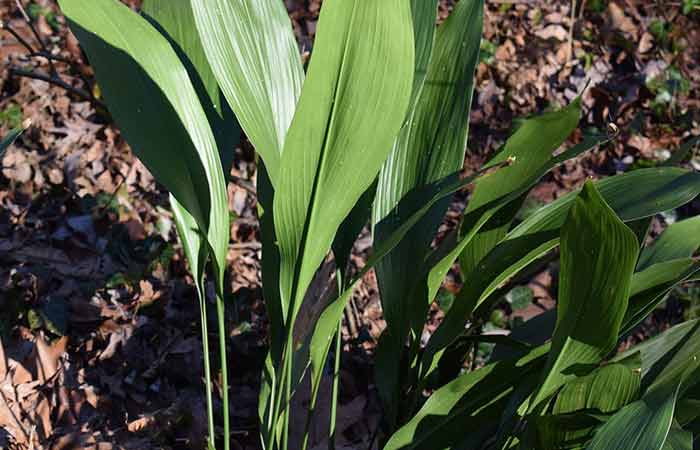
Cast Iron Plant is a low-light plant that can tolerate temperatures of between 10 and 27 degrees Celsius, which are actually present in the bathroom.
Zanzibar Gem
Also known as ZZ plant, Zuzu plant, aroid palm, eternity plant or emerald palm, the Zanzibar gem plant is almost indestructible and can put up with any sort of growing conditions ranging from low light, high humidity, low water levels as well as rapid temperatures switch.
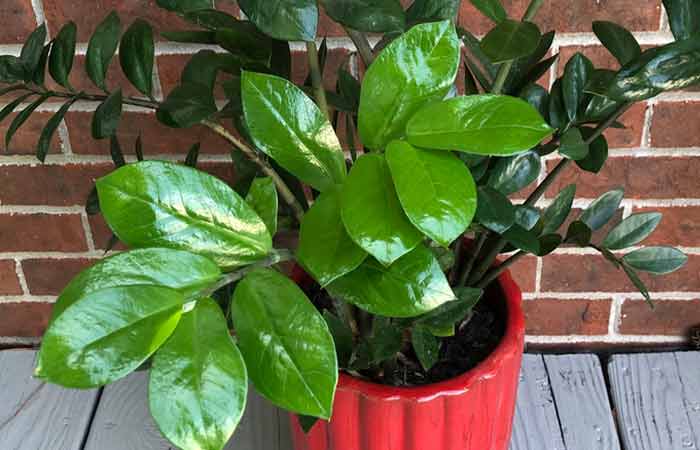
This bathroom plant needs to be watered only four times a year. Its elegant oval leaves will grace your bathroom for many years.
Bird’s Nest Fern
Bird’s nest ferns can add a jungle vibe to your home with their wavy green leaves rising from a central rosette. The frond emerging from the rosette resembles bird eggs, hence the name.
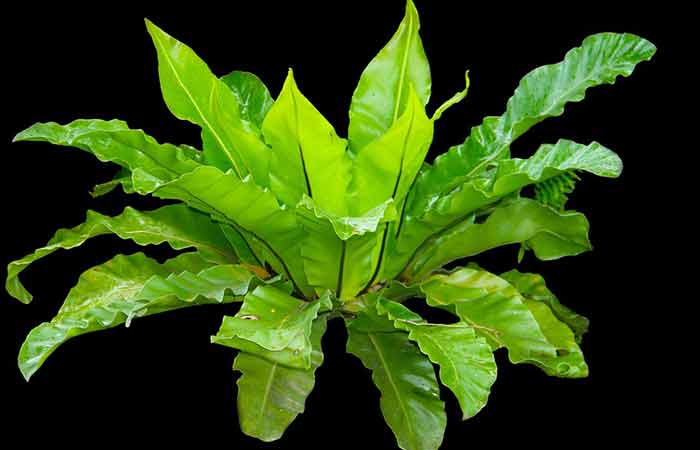
They love the extra moisture in the hot, humid environment present in the bathroom. Their leaves harvest the moisture and use it to nourish themselves. In less humid areas, bird nest ferns quickly dry up as they cannot absorb the water.
Water it weekly to keep the soil moist, and provide with a bit of morning light; if you grow your bird’s nest fern in insufficient light, it will grow its wavy fronds flatter than in satisfactory amounts of light.
With these conditions the Bird’s Nest Fern becomes big with beautiful dark leaves that improve the appearance of your bathroom.
However, you may need enough space to plant Bird’s Nest Fern, as it will ultimately grow bigger. Expect a fully grown specimen to be relatively big, up to 80 cm long and 20 cm wide.
Philodendron
These plants are native to the tropics and therefore quite attuned to the conditions of any muggy bathroom. Some varieties trail while others can grow up to about 8 feet (2.44 m), so make sure you make the right choice for your bathroom size-wise.
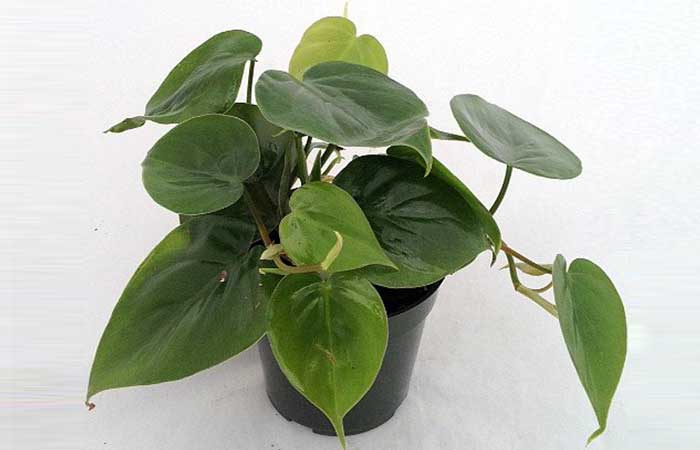
The philodendron requires bright, indirect light to grow, so putting it next to a window with a curtain is a good idea. Put your philodendron in a well-drained container, and water it regularly, especially when it gets hot outside.
This plant has a special way of telling you whether you have over-watered or under-watered it by dropping its leaves.
Best Hanging Plants for Your Bathroom+ Hanging Ideas
Nerve Plants
These plants have thin whitish veins prominent on their dark leaves. They are also humidity absorbing plants.Nerve plants like their soil to be constantly moist.
Further, they require a high amount of ambient humidity similar to that found in rainforests.
They help absorb much of the vapor content, lowering the surrounding temperature and humidity levels in your bathroom.
They are not suitable for new plant parents. Furthermore, they can be quite tricky to care for because they cannot tolerate direct light and stagnant air.
Snake Plant
Also going by the charming name of the mother-in-law’s tongue, the snake plant may sound like trouble, but it is actually one of the best plants you could put in your bathroom. The nickname mother-in-law’s tongue comes from the plant’s leaves that have points.

The plant has striped color, which earned it the name snake plant because it slightly resembles a snake’s skin. There are around 70 different species of snake plant, all native to tropical and subtropical regions of Europe, Africa, and Asia.
They are all evergreen and can grow anywhere from 8 inches (ca. 20 cm) to 12 feet (3.66 m) high.
Not only does it absorb excess moisture, it also filters common household toxins such as formaldehyde.
The plant comes in a massive range of leaf shapes and colors, many of them reminiscent of snakeskin, but it requires little more than occasional watering to survive in low-light, high-humidity environments such as tropical jungles and modern bathrooms.
Cyclamen
A sweet-scented plant with upswept petals and heart-shaped, patterned leaves, the cyclamen is certainly one pretty addition to your bathroom. Other than catching the eye, however, it will also lower humidity levels and freshen up the air you breathe.
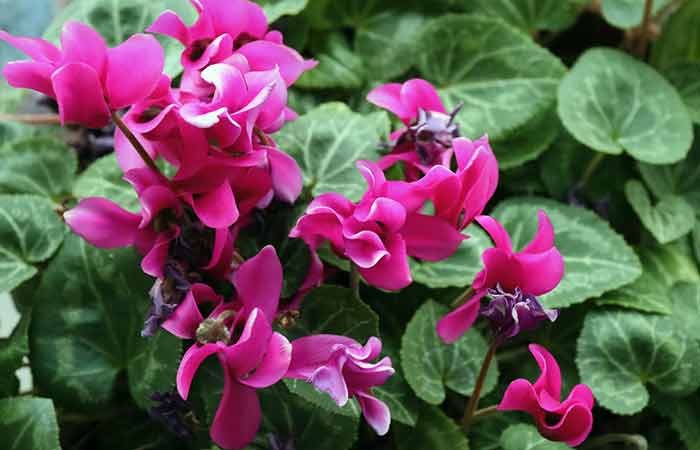
A little morning sun will keep it blooming. Protect it from cold drafts and harsh afternoon sun. This hardy plant will thrive on neglect, perfect for dark or infrequently used bathrooms.
Plant it in a well-drained container and water your cyclamen when the soil becomes dry at the top.
Begonia
A sprawling genus of 1,800 plant species, begonias typically fare well in pots – as well as in hot, humid bathrooms. Native to moist, tropical climates, most cultivars will devour your bathroom of damp air and decorate it with a cluster of colorful, fragrant flowers.
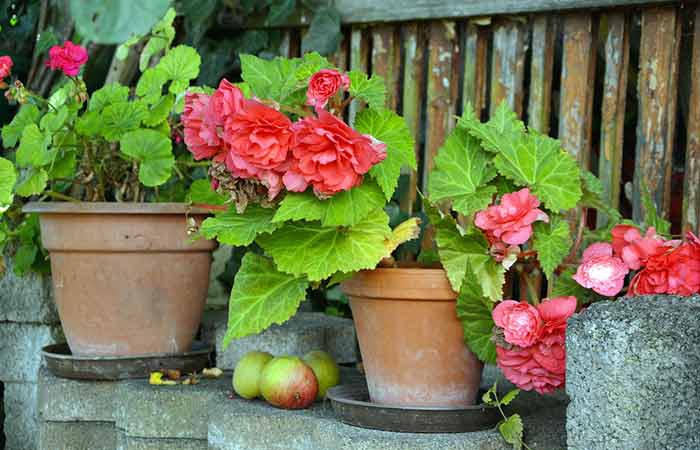
Go for a fibrous or rhizomatous variety (likely the two most household-friendly ones), and expose your begonias to some dappled sunlight in the morning. Do keep them away from your pets, though, as the roots are very poisonous.
Tillandsia
The funnel-shaped plants with their triangle-shaped leaves, tillandsias, are a unique variety in houseplants. They are epiphytic plants, which means they do not live in soil and get their nutrients from the air. Air plant is the other name for a tillandsia plant.
They are quite efficient in absorbing moisture from the air. Thus, air plants can help in reducing the air’s water vapor content, making it feel less warm. The plant that can survive the blackest of black thumbs, tillandsia doesn’t need soil, much sunlight, and barely even water.
Spider Plant
Spider Plant is an evergreen, perennial plant with tuberous roots and tuft appearance. At height and diameter it does not exceed 50 cm, but it can be spread on the ground and cover a considerable area.

Its foliage is of medium density, and has a fine texture. As a pot or indoor plant, it may have an attractive appearance of hanging from.Spider plants have long and skinny foliage that arch out from its roots.
Its leaves resemble the legs of a spider. Spider ivy and ribbon plants are the other names for spider plants. These plants can produce small white flowers when cared for correctly and sprout spiderettes, or baby spider plants that can be repotted to grow more spider plants.
Spider plants absorb water using their slender leaves, which lowers the moisture level in the air. This also helps in keeping their leaves fresh; otherwise, they start to brown and crisp.
The spider plant is also one of the most adaptable plants and an efficient remover of air pollutants and humidity. It requires little effort on the owner’s part, and it thrives in humid, low-light environments, all of which makes it a truly quintessential bathroom plant.
Reed Palm
Reed Palms thrive best in tropical and humid areas. The bathroom has the same warm and moist environment just like the tropical areas; hence this plant thrives well in the bathroom.
These bathroom plants have proven over and over again to be good at excess moisture absorption, air purification as well as ability to grow under low light, hence another good choice for your bathroom.
Peace Lily
The peace lily, also known as the spathe flower or white sails plant, is the common name for several species in the Spathiphyllum genus. Contrary to the name of this plant, a peace lily is not a true lily at all.

The white petal it has is actually a leaf bract that grows around the yellow flower. Standard peace lilies can grow between 24 and 40 inches (1.02 meters), so they are mostly used as floor decor in the bathroom.
Peace lilies enjoy low to medium light and can also thrive on fluorescent light.The peace lily wears a crown of white flowers, but uses its leaves to suck moisture from the air and also remove toxins in the process.
Only water it when the soil dries out, especially when the plant’s leaves start to droop.It does well in low light, but place it beside a window with some sunshine, and it will reward you with a more generous blossom.
The peace lily enjoys consistent warmth, so try to protect it from cold drafts and rapid temperature changes.
Boston Fern
The Boston fern is a frilly, grassy-green fern that’s refreshingly fancy to see around the house. It’s a sword-type fern that came all the way from moist forests and swamps.

It has several names such as Boston sword fern, wild Boston fern, Boston Blue bell fern, tuber ladder fern, or fish bone fern.
This lovely tropical plant has lacy fronds and thrives best in moist climates, and can therefore absorb your bathroom humidity with ease. It does best in indirect sunlight, but can burn rapidly in afternoon sun.
This plant can absorb excess moisture from your bathroom without much of a struggle, a characteristic that enables it to balance out the humidity levels, leaving your bathroom more comfortable.
Water your fern monthly when the soil is dry to the touch, and mist the leaves in the winter so that they don’t dry out too much.
Azalea
Azaleas naturally love warm, humid environments. A steamy bathroom with some morning sun will keep the colorful blossoms happy and healthy. The best type of azaleas for indoors are greenhouse or florist azaleas.
With probably the most beautiful blooms in the business, the azalea will paint your bathroom vividly purple, pink, red, or white. Keep it in a well-drained container and water it regularly, during hot summer months in particular.
Potted azaleas don’t grow too big and only grow slowly, but they can still be poisonous for pets. You may also need to prune the roots back every year. The roots could strangle the root ball and harm the plant if left alone.
Calathea
Calatheas have beautiful green foliage, and to maintain the shape and texture, they require high water content in their environment. This herbaceous perennial plant that grows up to a height of between three and six feet.
With a seemingly endless choice of leaf patterns and colors, calathea is a stunning plant for darker corners of the bathroom. Their large, broad leaves allow them to take advantage of even minimum light sources.
Their leaves curl inward when they don’t get to collect moisture from the air. These humidity-absorbing plants do well in brightly lit conditions, but harsh and direct sunlight can bleach their leaves.
Calatheas enjoy a lukewarm shower when the topsoil is dry. Because it is sensitive to cold and dry air and certain metals and minerals found in water, keep it safely out of drafty areas and only use filtered or distilled water.
With these plants, it’s best to incline towards less watering than overwatering. It can bounce back from under watering, but too much water in the soil will mark its death. The humid steam produced by a relaxing shower or bath is perfect for this plant.
Bromeliads
Many varieties of bromeliads are epiphytic and bask in the humidity of a bathroom.
They can get most of their moisture from the air. Bromeliads like bright but indirect light and dislike sitting in wet soil.
Aloe Vera
This succulent plant needs low amounts of sunlight, and fewer water requirements and the humidity in your bathroom will be perfect enough to keep it healthy.
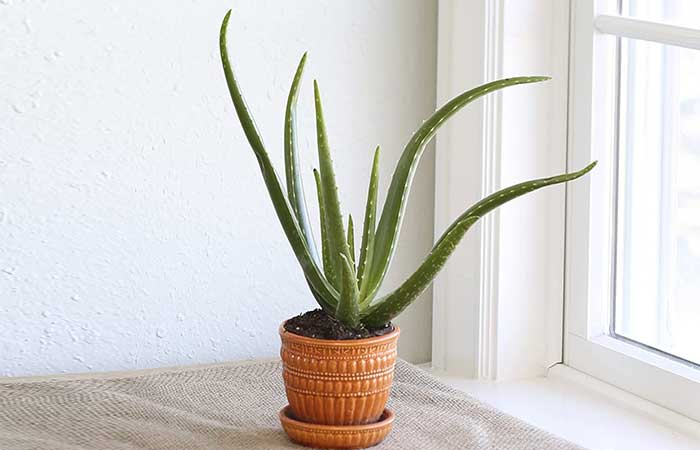
Apart from the fact that Aloe Vera beautifies your bathroom, it is also incredibly useful, especially when immediate relief from sunburns, cuts, or bug bites.
Baby’s Tear
A bright-green delicate creeping herb that trails prettily over wall-mounted planters or hanging baskets.
It prefers shade and moisture, making it ideal for bathrooms with low levels of natural light.
Orchids
Orchids are another type of plant that can absorb moisture from the air in your bathroom. Some types of orchids grow in the soil, while others are epiphytes and grow in the air.
For soilless orchids, their growing medium should be able to provide moisture and support. You can opt for sphagnum moss, peat moss, or fir bark for these orchids.
These humidity absorbing plants require bright, indirect light to survive. In the growing season, they produce blooms that add to the aesthetic value of your space.
Pothos
Pothos is a hardy, easy-to-care-for plant that can survive in most spaces, hence sometimes referred to as a cubicle plant. It can tolerate the high humidity in your bathroom.
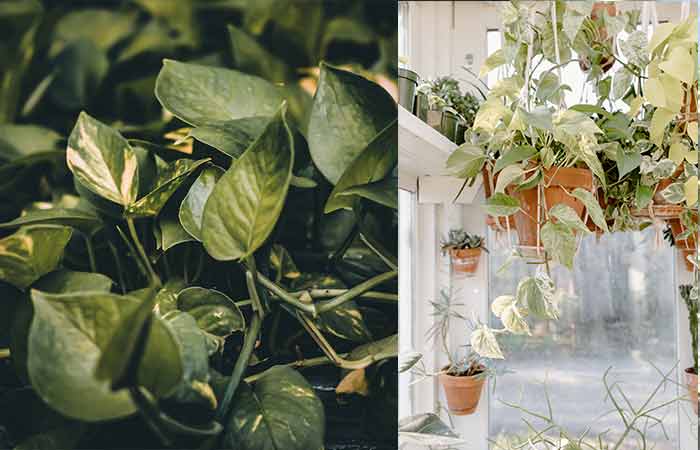
Moreover, it can withstand low light levels and irregular watering schedules.This bathroom plant is fast-growing and flourishes into a beautiful hanging vine, especially when suspended from the shower curtain rod.
English Ivy (Hedera helix)
The English Ivy is a great indoor plant that you can consider placing in the bathroom in hanging baskets.
This plant is ideal for reducing the impurities in the air, especially formaldehyde that’s more present in household products like bathing soap, cleaning detergents, furniture, and treatments for carpets. It’s also an ideal plant for absorbing moisture from the air in the bathroom.
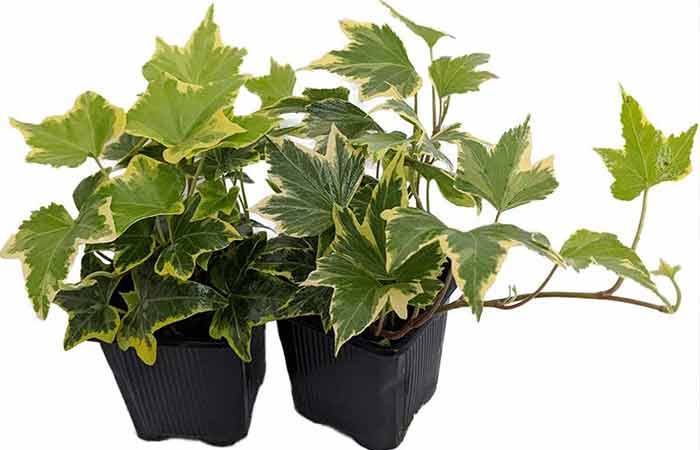
The ivy will also help you get rid of mold that grows in areas with high humidity. With little maintenance and low light requirements, it is easy to keep English Ivy in your bathroom, provided that you always keep the soil/ potting mix moist.
Bamboo Palm
With their thin, dark green leaves, bamboo palms are plants that absorb humidity and enjoy warm weather.
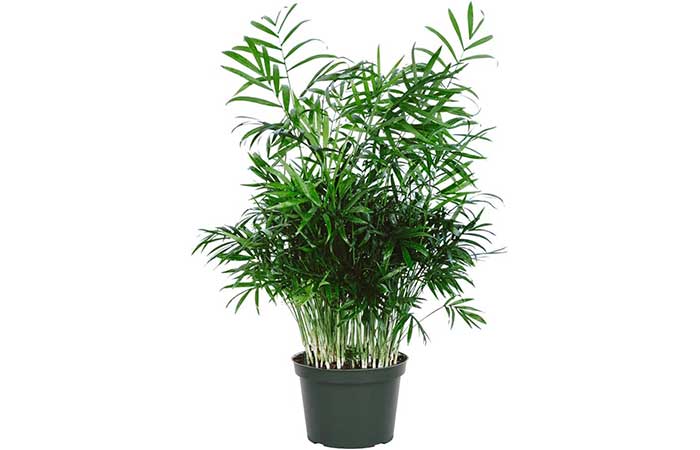
They can do well in medium to low light conditions, which makes them perfect houseplants. You should keep their soil moist, especially in summer, to avoid crispy leaves. In high humidity, their leaves will have a slight shine due to added moisture.
Putting one or two huge bamboo palms in your bathroom helps in reducing the air-water content. When humidity levels are challenging, it gives a cool and relaxed feeling.
Why Absorbing Moisture from the Bathroom is Important
It prevents the development of molds and mildew in the bathroom, which is caused by high humidity levels.
It also prevents excess condensation on Windows, wet spots or stains on walls and ceilings and musty smells in the bathroom.
Low humidity makes warm air feel cooler.